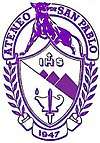Ateneo de San Pablo
The Ateneo de San Pablo, also referred to by its acronym AdSP was a private Catholic basic education institution ran by the Philippine Province of the Society of Jesus in San Pablo City, Laguna, Philippines. The school was opened in 1947, and was the sixth school named Ateneo by the Jesuits. It was closed in 1978 after the Jesuits agreed to redonate the Ateneo campus to the newly created Diocese of San Pablo. Ateneo de San Pablo was a small school since it was only a high school from 1947 to 1961. In 1962, it became a medium-size school when it opened its grade school.
Athenaea Sancti Pablensis (Latin) | |
The Jesuit school in Southern Tagalog region, Philippines | |
| Motto | Omnia in Christo (Latin) |
|---|---|
Motto in English | All in Christ |
| Type | Private college-preparatory school Roman Catholic Basic education institution |
| Active | July 1, 1947–1978 |
| Founder | (Jesuit) |
Religious affiliation | Roman Catholic (Jesuit) |
Academic affiliations | PAASCU |
| Address | Marcos Paulino St. Brgy Poblacion , , , 14°4′0″N 121°20′0″E |
| Campus | Urban |
| Alma Mater song | Hail, Ateneo, Hail! |
| Yearbook | The Purple |
| Colors | Purple and White |
| Nickname | Ateneans |
| Mascot | Purple Panther |
History
Before World War II, the Jesuits accepted the invitation of Most Rev. Alfredo Versosa, D.D., Bishop of Lipa, to open a high school in San Pablo. The Bishop donated to the Jesuits the St. Francis Seminary buildings and the grounds adjoining it. War began before the school could open, and the war destroyed the buildings. But as soon as the war ended, the Jesuits began to carry out their part of the agreement.
Early in 1946, Fr. John W. McCarron, S.J. of Washington, D.C., USA came to San Pablo to clear up the debris in the buildings donated to them. When his community of two men, Fr. Paul V. Finster, S.J. a priest and Fr. Francis Reilly, S.J., a scholastic, arrived, there were already available five classrooms, a library of about 2000 books, offices, a basketball court and three living rooms. With the physical requirements of the school done, the Jesuits turned to work for the school's advertisement, government recognition and recruitment of lay personnel.
On July 1, 1947, the Ateneo de San Pablo was opened. Only first year high school students were accepted. sixty-nine students enrolled. A few months after the school opened, Fr. McCarron, the school's first Rector was reassigned. Fr. Finster became Rector.
Fr. Finster, the missionary priest from Long Island, USA continued with the rebuilding of the ruins. He was able to enlist the help of Carlos Dychangco, an architect who drew up the plans and supervised the work which started in June 1950.
In 1951, the Ateneo de San Pablo turned out its first graduates, 36 of them. In September 1954, Rev. Fr. Eusebio G. Salvador, S.J. succeeded Fr. Finster. During Fr. Salvador's term as rector, an auditorium-gymnasium was constructed, and the school chapel and Jesuit Residence were completed. In 1962, the Ateneo de San Pablo opened its grade school.
In 1967, the Diocese of San Pablo was created, separate from the Lipa Diocese. The diocesan officials thought it logical that the site for the seminary and diocesan curia be in San Pablo. After the creation of the diocese, the newly appointed bishop, Most Rev. Pedro N. Bantigue, D.D. asked the Society of Jesus to redonate the Ateneo building site to the diocese. The Jesuits agreed to execute a deed of redonation and the signing of the deed was scheduled on March 11, 1969. The Ateneans and many sympathizers staged rallies and demonstrations to prevent the signing of the contract and they succeeded.
In 1976, the Ateneo de San Pablo attained one of the most prestigious of its achievements. The school was accredited by the Philippine Accrediting Association of Schools, Colleges and Universities (PAASCU).
The following year, the Ateneo de San Pablo was again threatened by the same case of 1969. On February 26, 1977, the Rome Supreme Tribunal ordered the Jesuits to comply with the redonation agreement made previously with Bishop Bantigue. The signing of the contract was rescheduled for June 15, 1977. In April of the same year, the Jesuits received a letter from Rome explaining the order for the Jesuits to leave the Ateneo site and informing them that the Bishop will pay P850,000.00 as compensation for the improvements made by them on the site.
Ateneo community tried to prevent the signing of the deed but to no avail this time. The deed was signed and the ownership of the land and the buildings of the Ateneo was transferred to the Diocese. The twenty-eighth and last graduation day in the Ateneo de San Pablo was held on March 31, 1978, marking the end of a beloved institution. The Ateneo de San Pablo became the Liceo de San Pablo, a parochial school of the Diocese.
School Rectors
- John W. McCarron, S.J. - 1946-47
- Paul V. Finster, S.J. - 1947-54
- Eusebio G. Salvador, S.J. - 1954-60
- Santiago A. Gaa, S.J. - 1960
- John F. Moran, S.J.
- Ramon Enojado, S.J.
- James P. Dunne, S.J.
Alma Mater Song
Ateneo de San Pablo's alma mater song was Hail, Ateneo, Hail!, which is also used by other Jesuit institutions in the Philippines.
School name
The name Ateneo is the Spanish form of the Latin name Athenæum, which the Dictionary of Classical Antiquities defines as the name of "the first educational institution in Rome" where "rhetoricians and poets held their recitations." Hadrian's school drew its name from a Greek temple dedicated to Athena, the goddess of wisdom. The said temple, according to the Encyclopædia Britannica, was where "poets and men of learning were accustomed to meet and read their productions." Athenæum is also used in reference to schools and literary clubs. The closest English translation is academy, referring to institutions of secondary learning.
The Ateneo de San Pablo is not the only Jesuit school that the Jesuits named Ateneo. The Society of Jesus in the Philippines has established sixteen schools all over the Philippines since 1590 where nine of them were given the name Ateneo. Over the years, the name "Ateneo" has become synonymous with academic excellence.
School seal

.png)
The first is the official seal of the school. Ateneo de San Pablo's seal is different from the school seals of the other Ateneos which all have the shield of the family of St. Ignatius of Loyola.
School colors and mascot
The school colors of Ateneo de San Pablo were purple and white, while its mascot was the Purple Panther.
School publications
The newsmagazine of Ateneo de San Pablo was called the Ensign while the yearbook was called the Purple.
